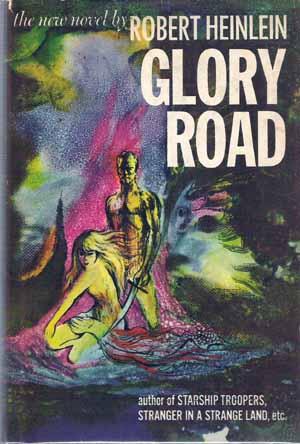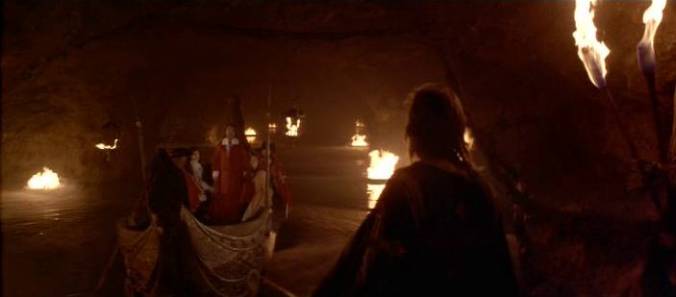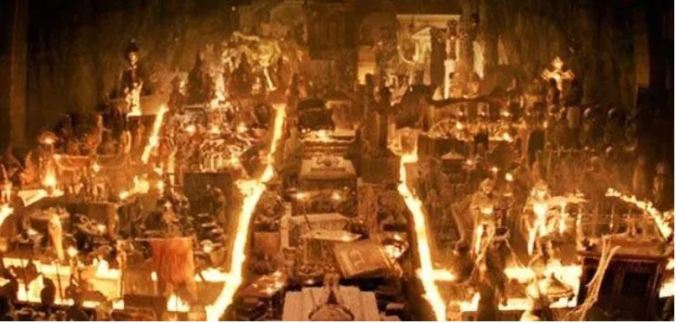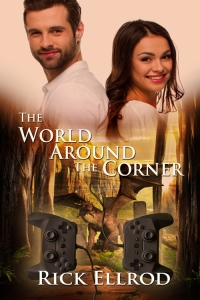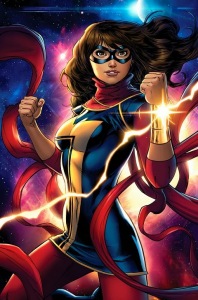Glory Road
A couple of comments by Kevin Wade Johnson in connection with my last blog post (now a long way back!) triggered a line of thought about heroes and the hero business.
Robert A. Heinlein’s 1963 novel Glory Road looks like a swashbuckling fantasy at first blush, but it turns into something entirely different. Our hero, E.C. “Oscar” Gordon, kicking around the world after leaving the military, is recruited by an incredibly gorgeous woman to assist her with a quest that involves traveling to other universes and swordfighting. This is just the kind of adventure he was craving.
As Kevin observes, the first three-quarters of the book are action-adventure, with sizable side dishes of comedy, scandalous liaisons, and cynical social commentary. At that point the quest is fully resolved—at page 208 out of 288, in my copy. What, then, occupies the rest of the book?
Gordon returns with “Star,” the beautiful woman he’s now married, to her home universe. It turns out she’s the empress of a multiuniversal polity that is in some respects a high-tech Utopia. All Gordon has to do is relax, allow himself to be fêted by the population, and sleep with anyone he finds interesting (the late Heinlein’s polyamory is fully on display here).
He hates it.
What Utopia doesn’t satisfy is Gordon’s lust for adventure. He doesn’t want to be a dilettante or a “kept man.” He wants wonder, excitement, the stimulus of danger. He likes being a hero, with all the occasional discomforts and perils of that role. The placid happy ending of a retired hero holds no attraction for Gordon.
It’s unclear whether Star feels the same way. She’s willing to consider going in on a kind of adventuring “business” with her slightly tarnished knight. But first, she says, she’d have to train a replacement for her unique position—and that would take many years.
The solution is for Gordon to head off again on the Glory Road without Star. He’ll pop back in now and then, but not to take up residence in the Twenty Universes utopia on a permanent basis. He and Star will remain in love with each other, perhaps, in some sense of the term—but not in a sense that requires fidelity on either’s part. In Heinlein’s polyamorous world-view, passing romantic involvements are just part of the adventure: “Knights errant spend their nights erring” (p. 271). Gordon’s happy ending is the continuing adventure.
The Unsettled Adventurer
This idea comes up from time to time in adventure stories: the hero (or heroine) who seeks out danger and isn’t content without it. John Carter of Mars displays a little of this, though in the violent world of Barsoom, he seems to be able to get his fill of trouble while still remaining home-based with the enthralling Dejah Thoris in her city of Helium. There’s something like this idea in the conclusion of The Good Place—boredom with utopia—as we’ve seen.
The really extreme case can be found in an old-time fantasy by E.R. Eddison, The Worm Ouroboros (1922). The swashbuckling nobles of Eddison’s imagined world fight the good fight against their sinister enemies, the Witchlanders. At the end of the novel, those adversaries are conclusively defeated. Cue the victory feast. And yet . . . Our Heroes are not quite satisfied. Things just won’t be as interesting without the Witchlanders constantly scheming and warring against them. At the very end, the heroes’ fanciful wish is somehow granted: a herald announces the arrival of an emissary from the bad guys—the same event with which the novel opened. (Hence the title: the legendary serpent that swallows its own tail.)
The Series Protagonist
I’ve previously expressed some doubts about whether happy endings really need to be static and boring—so let’s not adopt the Glory Road doctrine too hastily. (In its extreme form, Eddison’s circular epic, one may feel the opposite dissatisfaction in the sense that all the heroes’ striving and suffering has been for nothing.) But these examples highlight a difference among types of action heroes.
In a long-running action series, unless a hero is improbably falling into one adventure after another against their will, we have to assume that the hero likes what they’re doing. James Bond seems to be pretty content with his secret-agent life. Indiana Jones yearns for opportunities to climb out the window of his stuffy professorial office and strike out on some treasure-hunting chase—even at an advanced age, as we’ve recently seen. Captain Kirk, who’d been promoted to admiral by the beginning of Star Trek II, isn’t suited for a desk job. At the end of the three-movie cycle he’s demoted to captain again—ostensibly as a punishment for flagrant violations of Starfleet regs, but we’re to see this as a step forward for him, his best destiny. Yoda accuses Luke of this kind of unrest in The Empire Strikes Back: “Adventure! Excitement! A Jedi craves not these things.”
The same is true of almost all superheroes. Retirement is almost unheard-of. The occasional counter-example makes for an interesting tale precisely because it runs against type: Hank Pym in the Marvel Cinematic Universe, Jack-in-the-Box in Astro City. In a somewhat similar way, continuing campaigns in Dungeons & Dragons or similar games tend to assume the existence of a class of professional adventurers who enter willingly into a life of battle and treasure-hunting, as distinct from an assembled-for-one-purpose group like the Fellowship of the Ring.
This character trait does make things convenient for the writers. They have a believable rationale for the main character’s continuing adventures. Otherwise, after a while it would start to seem implausible for one person to keep getting drawn into danger purely by accident.
The Hero By Trade
The Star Trek captains, and other officers, illustrate a type of case where the character really is a professional hero—one who’s taken up a profession or vocation where danger and challenge, and hence the opportunity for heroism, come with the territory. Anyone pursuing a military or quasi-military career fills that bill. Honor Harrington, for example, reflects more than once that she’s good at war; it’s her calling, what she was born to do. Professional police officers, firefighters, or rescue workers—first responders generally—also fall into this category. (John McClane of Die Hard fame, mentioned above, is in a danger-prone profession, though it’s probably rare for a cop to run into the kinds of major crises he does.) Unsung heroes like medical personnel may find themselves in the same position. They may not categorize what they’re doing as heroism (it looks better on them if they don’t); but they are putting themselves “in harm’s way” where acts of heroism are constantly called for.
This is why military SF lends itself so easily to long-running series like Honor Harrington’s. (The same is true outside the SF genres, as we can see, for example, in Patrick O’Brian’s Aubrey/Maturin sea stories.) The same is true of private detectives, secret agents, and the like.
The Reluctant Hero
But not all heroes are professional heroes. An equally perennial favorite is the reluctant or accidental hero—the person who answers the call to adventure, but does wish to return to a peaceful life afterward.
Jim Butcher’s Introduction to Jim Butcher & Kerrie L. Hughes, Heroic Hearts (NY: Ace Books, 2022), puts it this way:
Real heroes . . . [are] the everyday humans who happen to be standing there when something bad happens, and when there is a sudden need for skill, courage, or intelligence. They’re the regular people in irregular circumstances who find themselves considering others first and standing up to do whatever needs to be done.” (p. xi)
Some do manage to go back to their ordinary lives after the crisis has passed. Cincinnatus, and George Washington, are famous for pulling off the transition: they took over the reins of the state when they had to, but willingly ceded power afterwards. On a more modest scale, the “citizen soldier” concept, as in the American National Guard, aims at the same thing. It’s part of the mystique of the American World War II armies, the so-called “Greatest Generation” model. You rise up to serve when necessary, but happily return to civilian life when it’s done. Contemporary discussions are more likely to emphasize post-traumatic stress disorder (PTSD) and the difficulty of the return to civilian life; but it remains an ideal with considerable drawing power.
In fiction, the contrast between heroic acts and ordinary life provides rich soil in which to grow interesting stories and characters. Tolkien, for example, gives us some characters who do manage the return to everyday existence—Sam Gamgee—and others who find it impossible, such as Frodo. Of course Frodo does in the end find peace in Valinor, but that requires a literal removal from the circles of the world, a transcendence not available to the average hobbit-in-the-street.
The situations can become fairly complex. In the Song of Roland, after the heroic deeds of the story are finished, a weary Charlemagne at the end finds himself called back unwillingly to new conflicts. In the TV series Chuck, the eponymous Chuck Bartowski is initially appalled to find himself embroiled in spy activities, but the sheer coolness of it all grows on him, and by the fifth season he wants to start his own secret-agent business. Scott Lang (Ant-Man) at the beginning of Quantumania is resting comfortably on his laurels, and has to be dragged back into action in the name of helping others.
Detectives in mystery stories fall into both camps. We have professional private eyes like Sherlock Holmes and Nero Wolfe. But then we also have amateurs like Chesterton’s Father Brown and Agatha Christie’s Miss Marple, who always just seem to be in the right place at the right time.
The Author’s Choice
If we want to write a heroic adventure story, one of the early decisions we have to make is what kind of hero we want to feature. Sometimes the tale may call for someone who’s automatically in a position to encounter danger, like a military officer. Sometimes we may prefer to drag the hero into action against their wishes, or by happenstance. The whole point of Roger Thornhill’s predicament in North by Northwest, for example, is that he has no desire to become involved in skulduggery and is baffled by the strange things that are happening to him. Like so many other accidental heroes, however, he rises to the occasion. This is a narrative arc that may be both more interesting and more inspiring than that of the professional hero; because most of us live relatively ordinary lives and can only hope that if called upon, we too could become the kind of hero we admire.
